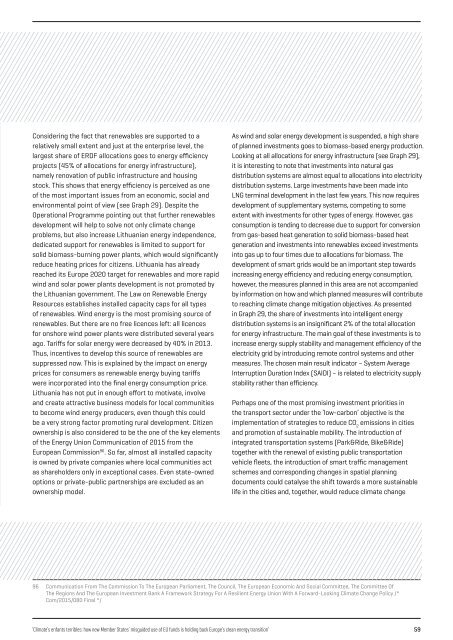ENFANTS TERRIBLES
enfants-terribles
enfants-terribles
You also want an ePaper? Increase the reach of your titles
YUMPU automatically turns print PDFs into web optimized ePapers that Google loves.
Considering the fact that renewables are supported to a<br />
relatively small extent and just at the enterprise level, the<br />
largest share of ERDF allocations goes to energy efficiency<br />
projects (45% of allocations for energy infrastructure),<br />
namely renovation of public infrastructure and housing<br />
stock. This shows that energy efficiency is perceived as one<br />
of the most important issues from an economic, social and<br />
environmental point of view (see Graph 29). Despite the<br />
Operational Programme pointing out that further renewables<br />
development will help to solve not only climate change<br />
problems, but also increase Lithuanian energy independence,<br />
dedicated support for renewables is limited to support for<br />
solid biomass-burning power plants, which would significantly<br />
reduce heating prices for citizens. Lithuania has already<br />
reached its Europe 2020 target for renewables and more rapid<br />
wind and solar power plants development is not promoted by<br />
the Lithuanian government. The Law on Renewable Energy<br />
Resources establishes installed capacity caps for all types<br />
of renewables. Wind energy is the most promising source of<br />
renewables. But there are no free licences left: all licences<br />
for onshore wind power plants were distributed several years<br />
ago. Tariffs for solar energy were decreased by 40% in 2013.<br />
Thus, incentives to develop this source of renewables are<br />
suppressed now. This is explained by the impact on energy<br />
prices for consumers as renewable energy buying tariffs<br />
were incorporated into the final energy consumption price.<br />
Lithuania has not put in enough effort to motivate, involve<br />
and create attractive business models for local communities<br />
to become wind energy producers, even though this could<br />
be a very strong factor promoting rural development. Citizen<br />
ownership is also considered to be the one of the key elements<br />
of the Energy Union Communication of 2015 from the<br />
European Commission 96 . So far, almost all installed capacity<br />
is owned by private companies where local communities act<br />
as shareholders only in exceptional cases. Even state-owned<br />
options or private-public partnerships are excluded as an<br />
ownership model.<br />
As wind and solar energy development is suspended, a high share<br />
of planned investments goes to biomass-based energy production.<br />
Looking at all allocations for energy infrastructure (see Graph 29),<br />
it is interesting to note that investments into natural gas<br />
distribution systems are almost equal to allocations into electricity<br />
distribution systems. Large investments have been made into<br />
LNG terminal development in the last few years. This now requires<br />
development of supplementary systems, competing to some<br />
extent with investments for other types of energy. However, gas<br />
consumption is tending to decrease due to support for conversion<br />
from gas-based heat generation to solid biomass-based heat<br />
generation and investments into renewables exceed investments<br />
into gas up to four times due to allocations for biomass. The<br />
development of smart grids would be an important step towards<br />
increasing energy efficiency and reducing energy consumption,<br />
however, the measures planned in this area are not accompanied<br />
by information on how and which planned measures will contribute<br />
to reaching climate change mitigation objectives. As presented<br />
in Graph 29, the share of investments into intelligent energy<br />
distribution systems is an insignificant 2% of the total allocation<br />
for energy infrastructure. The main goal of these investments is to<br />
increase energy supply stability and management efficiency of the<br />
electricity grid by introducing remote control systems and other<br />
measures. The chosen main result indicator – System Average<br />
Interruption Duration Index (SAIDI) – is related to electricity supply<br />
stability rather than efficiency.<br />
Perhaps one of the most promising investment priorities in<br />
the transport sector under the ‘low-carbon’ objective is the<br />
implementation of strategies to reduce CO 2<br />
emissions in cities<br />
and promotion of sustainable mobility. The introduction of<br />
integrated transportation systems (Park&Ride, Bike&Ride)<br />
together with the renewal of existing public transportation<br />
vehicle fleets, the introduction of smart traffic management<br />
schemes and corresponding changes in spatial planning<br />
documents could catalyse the shift towards a more sustainable<br />
life in the cities and, together, would reduce climate change<br />
96<br />
Communication From The Commission To The European Parliament, The Council, The European Economic And Social Committee, The Committee Of<br />
The Regions And The European Investment Bank A Framework Strategy For A Resilient Energy Union With A Forward-Looking Climate Change Policy /*<br />
Com/2015/080 Final */<br />
‘Climate’s enfants terribles: how new Member States’ misguided use of EU funds is holding back Europe’s clean energy transition’ 59


